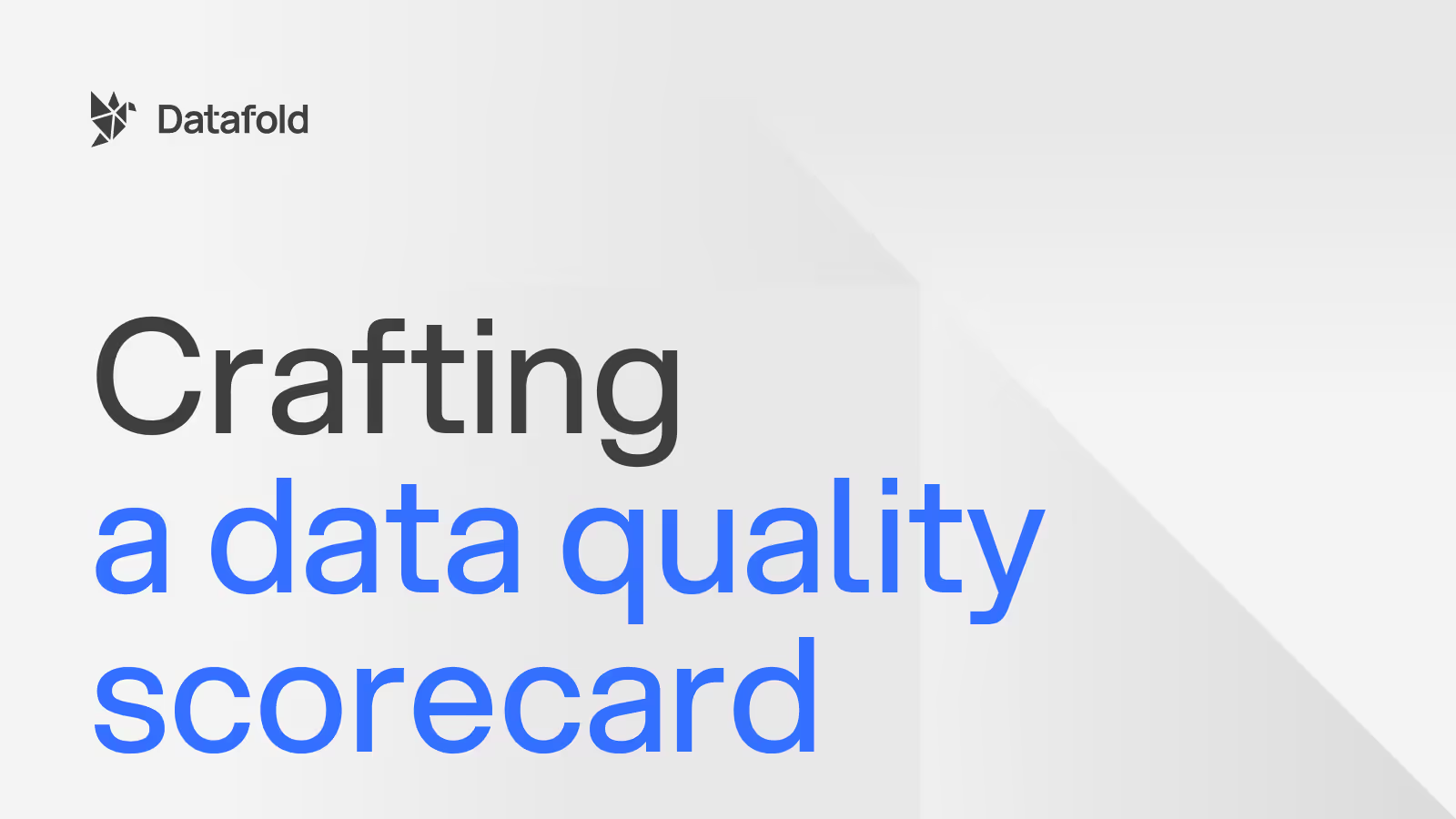Crafting a data quality scorecard
Understand why a data quality scorecard looks different for every team, how to craft one aligned to your data management goals.

Some questions are a clear “yes” or “no.” Is there milk in the fridge? Did I bring out the garbage? Is Con Air one of the greatest films ever made?
Other questions seem like they should be a clear yes/no, but they’re not. For example, you’re having a one-on-one call with your boss and they ask, “The CEO was asking about some AI initiatives and asked whether we have good data quality. Do we?”
What can you tell the boss and what is the answer to the CEO’s question? You could go on a five-minute diatribe about all your data quality work and that the ship needs more power but the dilithium crystals are nearly drained.
Or, you could just email a link to your data quality scorecard.
“Oooh, what’s that?” I hear you asking quietly under your breath. Well, let’s dive right in!
Data quality management: Like whack-a-mole for data
Data quality isn’t easy to manage. In principle, it’s simple: make sure your data is accurate, complete, consistent, and reliable at all times for every system and downstream consumer who needs it. Okay, maybe that doesn’t sound so simple. But in an ideal world, we’d get pristine, accurate data from all of our sources and we’d be able to do analytics work right after it hits the warehouse.
Unfortunately, data quality management is a bit like playing whack-a-mole. There are eight dimensions to data quality to pay attention to, and any day, something weird can happen with any one of them. It’s your job to respond to those issues and make sure stuff doesn’t go sideways.


Here are those eight dimensions, presented in no particular order:
- Accuracy: The data represents reality
- Completeness: All the required data is present
- Consistency: Data is consistent across different datasets and databases
- Reliability: The data is trustworthy and credible
- Timeliness: Data is up-to-date for its intended use
- Uniqueness: There are no data duplications.
- Usefulness: Data is applicable and relevant to problem-solving and decision-making
- Differences: Users know exactly how and where data differs
Each dimension can be measured, quantified, and aggregated to present a meaningful picture of your data quality. You’ll never be able to say your data is perfect, but you can always strive for 100% accuracy, completeness, consistency, reliability, and so forth.
If you don’t believe this is feasible, check out how Rocket Money figured it all out, including SOX compliance and zero data deficiencies found in their audit report. The secret to their data quality strategy success: automation (and Datafold — obviously).
When you’ve got data quality checks, automated testing, and a functioning CI/CD pipeline managing all your data work, you’re well on your way to high data quality. After all that stuff is in place, you can present it in a nice, fancy scorecard.
Fundamentals of a data quality scorecard
A data quality scorecard is kinda what it sounds like. It’s a dashboard that presents all of your data quality measures and dimensions in one place. A good scorecard is easy to read, understand, and share with anyone who needs it.
Here’s what you might find on such a scorecard:
- Data quality dimensions: Metrics for accuracy, completeness, consistency, timeliness, etc.
- Scores and ratings: Quantitative data quality scores (e.g., percentages) or ratings (e.g., grades) for each dimension
- Visualizations: Charts, graphs, or dashboards to illustrate data quality status
- Thresholds: Benchmarks for acceptable quality levels
- Issues and anomalies: Identified data quality issues with details and severity
- Trends over time: Historical data showing improvements or declines in overall data quality
- Action items: Recommendations or tasks for addressing data quality issues.
Obviously, there’s no such thing as a “standard” scorecard, nor are there particular industry best practices. It can be beautifully designed with incredible UI/UX or it can look like it was thrown together during a caffeine-fueled all-nighter with Comic Sans as the main font. The only thing that matters is that you’re collecting and sharing the data.
You can’t have a scorecard if you’re not measuring data quality, and you can’t manage your data quality if you’re not measuring each dimension.
Designing a data quality scorecard
If you’re able to have a scorecard in the first place, good on you. That’s a huge achievement and puts you well ahead of many of your peers. (I don’t know if this is true, but you can take the compliment.) In all seriousness, it is an actual achievement. Measuring data quality is an important and difficult thing to do.
A good scorecard doesn’t just present a bunch of data quality metrics, though. It needs to actually be informative and helpful to the people who are reading or using it. Getting to this point requires actually knowing what other people need from the scorecard and having a feedback loop in place to know that they’re satisfied.
Here’s a high-level step-by-step process you can follow to design a good scorecard:
- Define important data quality metrics: Find out who needs the scorecard and determine what it is they need to see (and why)
- Identify the data: Based on the requirements you’ve gathered, determine exactly what data needs to be calculated and presented on the scorecard
- Set thresholds: Not everyone knows what a good metric is for each dimension, so you should determine thresholds based on your goals. For example, 85% accuracy may be unacceptable at one company, but fantastic at another
- Select the right tools: You could build a scorecard in Excel, but would you really want to? See what tools you have available in your organization that could help you visualize and present the scorecard data to the people who need it
The more useful a scorecard is, the more likely it is that you’ll get feedback from people across your company who want to use it. At some point, you’ll need to be thinking about how to manage the scorecard like an internal product or tool. So, keep that in mind when you get started. Don’t design for day 0, design for long-term success.
Implementing a data quality scorecard
A scorecard can be more than just a pretty dashboard. It can have hooks for automation that trigger messages in Slack or other functions. You probably don’t want to start with a requirement like that for your MVP, but it’s important to think about the 2nd- and 3rd-order consequences of this thing becoming an important asset in your organization.
The success of your scorecard isn’t a matter of luck or happenstance. You can actually do some strategic legwork to help its adoption and make it widely-used. Treat it like an internal data product and do some of the following:
- Promote it! Tell everyone about your scorecard and get them to check it out. Send a company email out. Put an announcement in your company chat. Present it at an all-hands meeting. Show it off at a lunch and learn.
- Involve others: Just because it’s a “data project” doesn’t mean you can’t solicit the help of other teams. Reach out to a designer to make it attractive. Talk to a dev to implement the UI. Bring in a product manager to help you design requirements.
- Engage stakeholders: Don’t just tell your key stakeholders when the dashboard launches. Tell them every time you update it. Get them on a mailing list. Ask them for feedback to make it more useful and then implement those changes.
- Iterate and improve: This isn’t a one-and-done project. A good scorecard evolves over time with the needs of the business and as data changes.
- Automate automate automate: Do as much as you can to keep the scorecard as fresh and timely as possible with automated data collection and presentation.
Use data quality tools like Datafold to automatically validate your data pipelines. Besides keeping your data reliable and accurate, these tools will help you catch any discrepancies or anomalies before they become a problem. They also make your scorecard a trustworthy resource for organizational decision-making.
Monitoring and maintaining data quality
Keeping an eye on your overall data quality requires consistent attention and effort. You can’t just set it up once and forget about it. Here are some friendly tips and techniques to help you regularly monitor and maintain your data quality:
Techniques for regular monitoring of data quality
You can keep your data data reliable and accurate by following these key techniques:
- Set regular check-ins: Make it a habit to review your data quality scorecard regularly. Schedule weekly or monthly meetings to go over key data quality metrics. Doing so will keep everyone in the loop and allow you to spot data quality problems early.
- Automate alerts: Use automation tools to alert you when certain data quality metrics fall below a threshold. You can have them sent to your inbox or Slack channel so you’re always update to date.
- Use visual dashboards: Visualizations make it easier to see trends and spot anomalies. A data quality dashboard gives you a clear overview of everything, helping you quickly identify areas that need attention.
Consistently applying these techniques will enhance the accuracy and utility of your data. They’re also a great way to build a data-driven culture within your team.
Strategies to maintain high data quality
To maintain high-quality data, it's essential to proactively manage the integrity of every data source. For consistent results, consider adopting these effective strategies:
- Regular audits and reviews: Schedule a periodic data quality assessment of your metrics to ensure standards are consistently met and maintained.
- Training and development: Continuously train team members on the latest data management practices and tools to keep everyone up-to-date and skilled in maintaining data quality.
- Feedback mechanisms: Implement a system for collecting and analyzing feedback from data users to identify areas for improvement and quickly address any data quality issues.
- Technology updates: Regularly update your data management tools and technologies to adapt to new challenges and leverage advancements in data processing and analysis.
Taking these steps to heart is an easy way to maintain high quality data. While these actions might seem straightforward, combining them can really amp up the effectiveness of your data-driven strategies.
Datafold: Enhancing your data quality scorecard
Pulling Datafold into your data quality efforts is a quick way to take your scorecard to the next level. It’s no mystery as to why. Datafold’s automation skills help you spot data slip-ups before they disrupt your workflow. It’s just smart to spend less time fixing data and more time on leveraging trustworthy data. Plus, when you sync Datafold with your scorecard, you set the stage for continual improvement across your organization.
Ready to optimize your data quality scorecard? Discover how our expertise can guide you in building a robust scorecard that ensures your data stays precise, consistent, and actionable. Let's elevate your data management together:
- Sign up for a 14 day free trial of Datafold to explore how data diffing can improve your data quality practices within, and beyond, data teams
- Book time with one of our solutions engineers to learn more about Datafold and how it will integrate with your tech stack

.avif)



